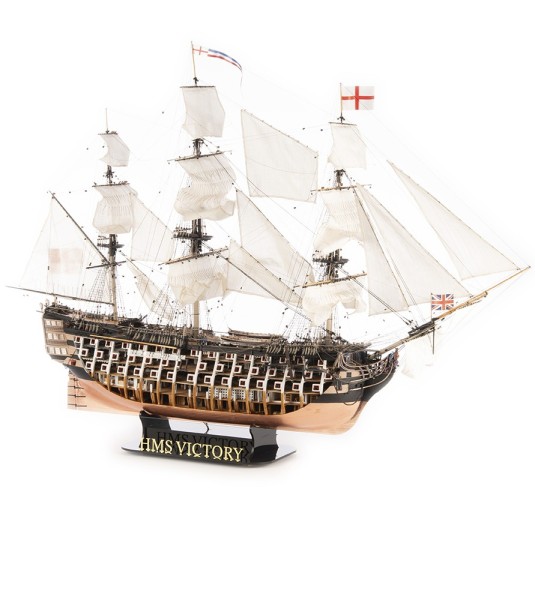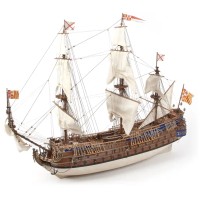- Order number: at22900-OP
- Hersteller: Artesania Latina
- Zustand: Neuer Artikel
HMS VICTORY model kit - ANATOMY version, scale 1:84
The HMS Victory is one of the most famous and longest-preserved warships in the world. She played a crucial role in the history of the Royal Navy and is best known for her participation in the Battle of Trafalgar in 1805. Here is a detailed account of her history:
Construction and early years
The keel of HMS Victory was laid on 23 July 1759 at the Chatham Dockyard. She was built as a first-rate ship of the line, which meant that she was intended to be the largest and most powerful ship in the fleet. At around 69 metres long and displacing some 3,500 tonnes, she was equipped with 104 cannons on three decks. She could accommodate a crew of about 850 men.
Construction took six years, and the ship was finally launched on 7 May 1765. Her name ‘Victory’ was chosen in honour of an important British victory in the Seven Years' War. Initially, however, HMS Victory was not immediately put into service because there was no urgent need for such a large ship. Instead, she lay in reserve for several years.
Service in the Royal Navy
In 1778, the Victory entered active service under the command of Admiral Augustus Keppel and took part in the Battle of Ushant during the American Revolutionary War. At that time, the ship was already notorious for its striking power and manoeuvrability. In the years that followed, the Victory took part in various engagements, including the Battle of Cape St. Vincent in 1797, in which Admiral Sir John Jervis, with a numerically inferior squadron, won a significant victory over the Spanish.
Conversion and preparation for Trafalgar
At the beginning of the 19th century, the Victory was thoroughly overhauled to bring it up to date with the latest technology. In 1803, Admiral Horatio Nelson took command of the British Mediterranean Fleet, which was stationed on the Victory. Under Nelson, HMS Victory became the flagship of the British fleet.
The Battle of Trafalgar (1805)
The HMS Victory is most famous for its crucial role in the Battle of Trafalgar. On 21 October 1805, the combined fleets of France and Spain, under Admiral Pierre-Charles Villeneuve, encountered the British fleet, commanded by Admiral Nelson. The battle took place off the coast of Spain, and Nelson opted for an unconventional tactic. Instead of fighting in a traditional line, he ordered the opposing fleet to be split into two columns in order to break through their line formation.
The HMS Victory led the British fleet and was one of the first ships to enter the fray. She engaged in fierce duels with the French flagship Bucentaure and the Redoutable. During the battle, Nelson was fatally wounded when he was shot by a Redoutable marksman. Despite his death, the battle was won by the British and sealed their naval supremacy for the next 100 years.
Later years and retirement
After the Battle of Trafalgar, HMS Victory remained in service with the Royal Navy, although she was gradually replaced by newer ships. She served as a flagship in Portsmouth and was later moved to the harbour, where she was used as a training and administrative ship.
Over time, the ship began to deteriorate, and efforts were made to preserve her. In 1922, Victory was permanently moved to a dry dock in Portsmouth to be restored as a museum ship. She remains there to this day and is one of the UK's most popular tourist attractions.
Significance and legacy
HMS Victory is not only a symbol of British maritime heritage, but also a monument to the naval battles of the 18th and 19th centuries. It embodies the power of the Royal Navy at a time when Britain was considered the world's leading naval power. Today, it serves not only as a museum ship, but also as the flagship of the First Sea Lord of the Royal Navy.
Technical details of HMS Victory:
- Launched: 1765
- Length: 69 metres
- Beam: 15.8 metres
- Draft: 8.76 metres
- Displacement: approx. 3,500 tonnes
- Cannons: 104
- Crew: 850 men
The model kit
This kit is a truly extraordinary model of the English ship of the line from the 18th and 19th century. With its false keel and frame construction, this miniature is almost the same as the real ship. This anatomy version allows you to examine and recreate the construction and structure in detail, from the hold to the aft deck, while assembling the model. The model kit contains thousands of parts. These include 16 laser-cut plywood plates with engraved part numbers. Deck parts with engraved plank pattern. 15 laser-cut solid wood plates. 3 plates of intricate lime veneer parts. Laser-cut window panes. The set includes 8 sheets of brass photo etch parts. Three transparent boxes contain metal fittings. The cannons are particularly finely crafted. All woods, round rods and veneer strips are sorted, bundled and labelled. There is also a copper cladding for the hull, sewn and finished cotton sails. A complete set of rigging material is included. Paper templates help with the positioning of parts and openings. For assembly, you can follow our complete step-by-step instructions, which you can watch for free on YouTube (80 chapters). It will be like a master class conducted by professional model makers. The kit includes a printed summary of the building instructions (short version !!!) as well as printed plans of the boat.
A special treat is the model stand made of black acrylic glass and labelled with brass letters, where you can also hide the switches and batteries for optional lighting.
The model is absolutely true to the original and contains all the details from the hold to the aft deck, which can be seen through the open side of the hull on the right. It has the official licence of the National Museum of the Royal Navy.
Build this museum-quality model of one of the naval highlights of all time in 1:84 scale!
LED lighting, crew and officers are NOT included in the kit. Paints, glues and tools are also required.
This kit is not suitable for beginners.
Technical data:
Scale: 1:84
Length: 1202mm
Width: 470mm
Height: 805mm
| Material Rumpf: | Holz |
| Difficulty: | hard |
| Breite: | 470mm |
| Maßstab: | M 1:84 |
| Höhe: | 805mm |
| Länge: | 1202mm |
Excellence Model Kits S.L.
Calle La Orotava 87
29006 Málaga
España
- Kein Spielzeug
- Nicht geeignet für Kinder unter 14 Jahre
- Enthält verschluckbare Kleinteile





















































































